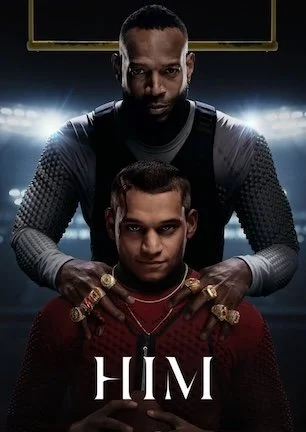Studio: Uncork’d Entertainment
Director: Glenn Douglas Packard
Writer: Darryl F. Gariglio, Glenn Douglas Packard
Producer: Noreen Marriott, Darryl F. Gariglio, Glenn Douglas Packard
Stars: Brian Raetz, Lindsey Nicole, Celina Beach, Ryan Moore, Keith Webb, Sheila Leason, Nicole Dambro, Vibhu Raghave, Daniel Wilkinson
Review Score:
Summary:
A masked maniac with a pitchfork for a hand terrorizes eight friends partying on a remote family farm.
Review:
Never mind being remembered in the long run. Contemporary slasher films have their work cut out for them when it comes to being noticed in the first place.
The 1980s ran the lather, rinse, repeat formula of masked maniacs stalking T&A teens deep into the ground. The subgenre’s early 21st-century resurgence beat a different dead horse through overreliance on ironic homage and nostalgia for entertainment value. Vague throwback appeal simply doesn’t cut it anymore. Nowadays, slaughter-spree fright flicks better have unique hooks or they can expect to be banished from existence as far as audience awareness is concerned.
Producers presume the road to recognition in this arena requires a franchise villain. Bits are chomped in anticipation that a certain combo of origin story, mask, and M.O. will bring in cha-chings as the next Freddy, Jason, or Leatherface. What is often overlooked is that horror icon status isn’t automatic because a desperate director hopes so or a press release says so. That’s an audience award, requiring personality and creativity to earn. And personality paired with creativity is something Pitchfork has in short supply.
Look at its art. Read a synopsis. Glance at some still frames or watch the full trailer. “Pitchfork” delivers precisely what that general impression probably expects. If you haven’t consumed enough similarly-styled films to know what that means, then “Pitchfork” provides a near-perfect reference point for what microbudget massacre movies usually entail:
Shot digitally. Runs 90ish minutes. Friends and family comprise the crew, sometimes with more than one credit to a name. Actors have spent more effort perfecting their headshots than honing their craft. Optimistic ambition exists on one side of the camera without production value to match on the other.
Those aren’t insults. Those are realities regularly faced in low-budget horror. Another reality confronted by “Pitchfork” is that its particular carousel of clichés is too half-hearted and uninteresting to justify ignoring its indie edges too.
Following an obligatory prologue kill, here comes an obnoxiously decorated party van of twentysomethings played by thirtysomethings, complete with one woman whoo-hooing out a window. Formerly-closeted college “kid” Hunter is on his way home to the family farm to officially come out to his disapproving dad and sympathetic mother.
Along for support, and to celebrate with a big barn dance number (director Glenn Douglas Packard has a background in choreography), are seven of Hunter’s friends. Of course they include a bespectacled good guy, a buoyant blonde good girl, a sultry sexpot with streaks in her hair, a selfish jock in a letterman jacket, the Professor, Mary Ann, and the rest.
First instinct is to offer benefit of the doubt and assume the movie might try something clever with the stereotypes. Why else would one girl be outfitted in Jane Fonda aerobics gear if not to wink at tropes of a bygone era?
Except “Pitchfork” doesn’t lean that way. Stabs are taken at some comic relief, like leotard lady’s ongoing attempt to bed an Amish boy in his buggy. But there isn’t any campy charm about how the formula itself is followed. The script even doubles down on “been there, done that” by including subplots about the good guy’s longstanding crush on the good girl BFF, and the jerk jock’s catting around on that good girl with her sassy rival, then plays those conflicts completely straight as if pat plotting is intriguing. What year is this again?
“Pitchfork” does next to nothing with the bit about Hunter’s homosexuality, another couple’s unexpected pregnancy, or other developmental details rendered irrelevant immediately after introduction. Once the titular terror starts creating corpses out of everyone at the farm, the movie is structured like a Bruce Lee fight scene. We watch whatever action the camera has centered while other characters, particularly those who temporarily survive only to disappear for implausibly long periods, patiently wait their turn to reappear.
As for Pitchfork himself, he isn’t much of a memorable murderer. His deal is he has a pitchfork in place of his left hand and wears an animal fur mask, sniffing around like an animal himself without ever speaking a word. That’s not nearly enough characterization to come within a mile of icon potential.
“Pitchfork” is at least in focus and properly lit, and would come close to evening out as average if not for a last act descent into tastelessness. One scene sees a woman stabbed in her genitals so Pitchfork can bathe in lower body blood. Another sees a mason jar full of urine poured on a victim’s face. This doesn’t make anyone onscreen more despicable or inspire any sort of scare. These are crude shocks misplayed as means to be menacing.
Unless you like a lot of low angles looking up from behind at the actresses, every one of whom wears Daisy Dukes, “Pitchfork” has only old hat on hand. An “oops, I though I was stabbing the killer, not my girlfriend” moment. A family of deranged hillbillies. Unnecessary asides about who is sleeping with whom. “Why are you doing this?” whining from victims.
One thing “Pitchfork” doesn’t have is the thing it needs most: An irrefutable reason to watch it when so many other slashers have done it better.
Review Score: 35






“Bone Lake” comes across as a genuinely committed attempt to craft a slick little film streaked with some slaughter and a slight touch of self-aware silliness.